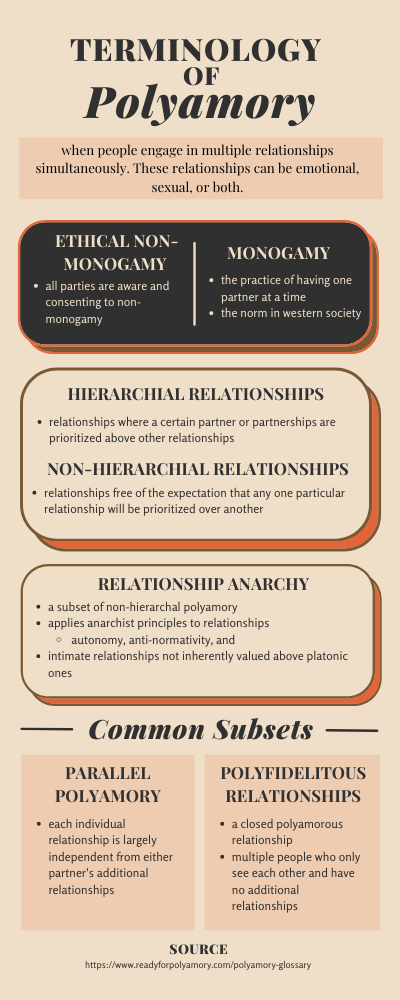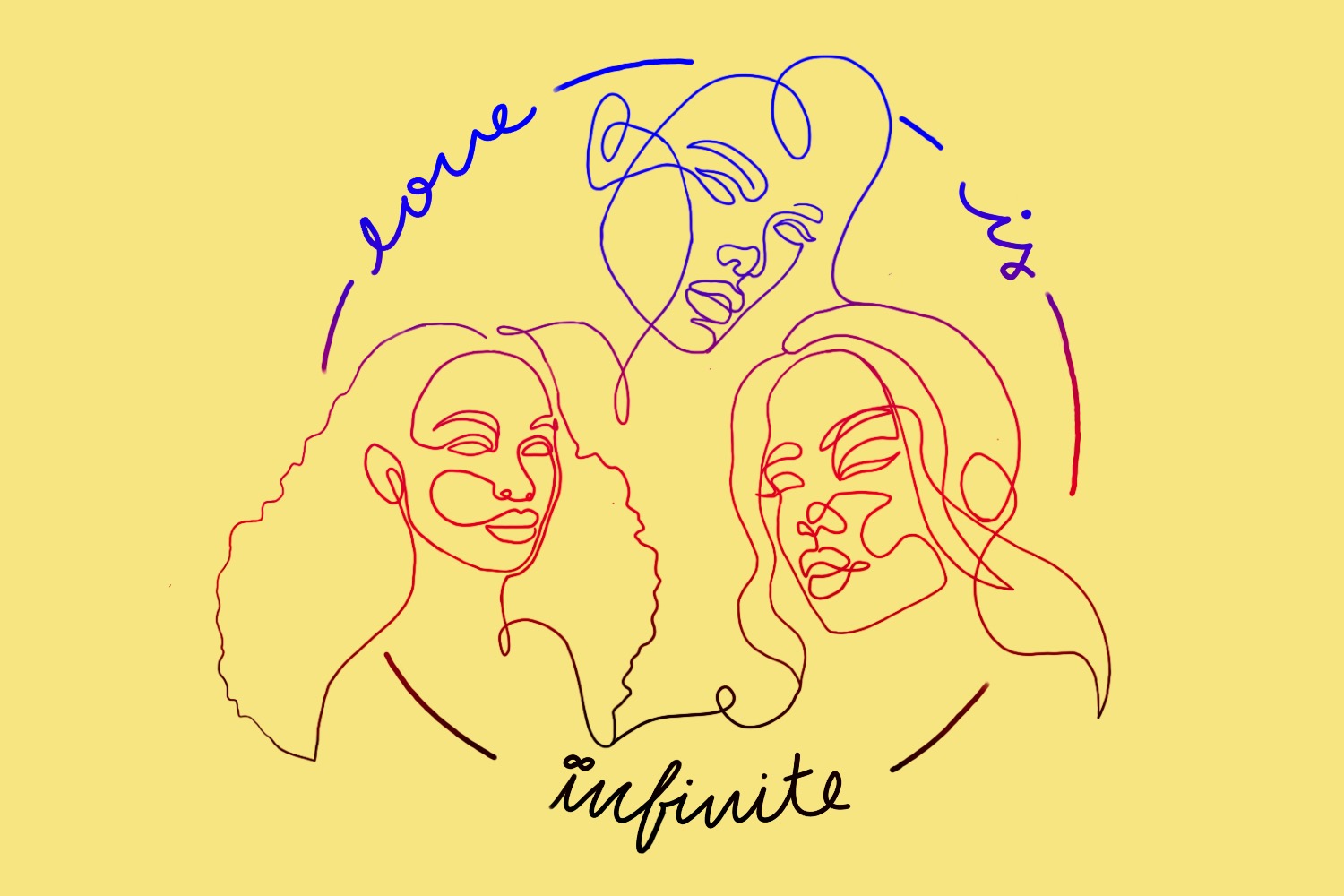
Love is infinite: de-stigmatizing polyamory
May 6, 2022
Love is infinite. This is a common saying in the world of polyamory and encapsulates the belief that love does not run out. It grows and changes but cannot deplete.
“I have a lot of love to give,” said Tahlia Lawson*. “I feel most happy and fulfilled when I have multiple loving relationships going at once.”
In recent years, society has become increasingly accepting of alternative relationship structures and ideas about relationships that go against society’s preconceived notions about relationships.
“I’ve never felt good about being with just one person,” said Sarah Moore*. “I’ve always cared about that one person, but I’ve never felt good.”
Much like sexuality and gender, romantic orientation is a spectrum. Many people feel traditional relationships don’t make them feel fulfilled and happy. In fact, some feel like they are missing something or suppressing a part of themselves.
Feelings such as these lead many to discover the world of polyamory.
What is polyamory?

“Polyamory” stems from the Greek word “poly,” meaning many, and the Latin “amor,” meaning love. As the name suggests, a polyamorous relationship is where people engage in multiple relationships. These relationships can be sexual, emotional, or both. It is one of the most prevalent forms of consensual non-monogamous relationships.
Even under the umbrella term polyamory, there are still numerous subsets such as polyfidelitous relationships, where groups decide not to become involved with people outside their existing relationship networks; or even parallel polyamory, where individual relationships are largely independent of each other.
“There are so many different styles of non-monogamy,” said Gina Westfall*. “Different people do it in different ways depending on how they naturally connect.”
Even though Westfall is a proud member of the polyamorous community, she wasn’t comfortable with her name being attached to it on the internet, as there is still immense stigma even in our sex-positive society. There are very few legal protections for those in the community against discrimination from their employers.
Gina Westfall
Gina Westfall is a 28-year-old from the Bay Area who first began exploring polyamory with her significant other in college.
“We really wanted to talk through what we wanted our relationship style to be,” Westfall said. “We knew a couple of people who were in polyamorous relationships, and we wanted to get rid of the many unhealthy things that can accompany monogamy. Mainly, we wanted to eliminate the idea of the relationship being about having total ownership over each other.”
People in romantic relationships often demand complete control over each other’s time, emotional and sexual connections. Some can view this as too domineering and wish for more independence and freedom from traditional romantic expectations.
This is one of the many reasons polyamory is so appealing to many people.
“If you feel a genuine connection with someone, you have the freedom to pursue a relationship,” Westfall said. “Both people will be able to have the relationships they both want without having arbitrary restrictions around them. We can choose our emotional and sexual connections as autonomous individuals while also taking care of each other and each other’s emotions within our relationship.”
These relationships don’t necessarily always have all three components of what society often views as a relationship: friendship or mutual feelings, romance, and sexual intimacy.
This is also one of the main reasons for non-hierarchical relationships; there isn’t the expectation that one particular relationship will be prioritized over another. Though prioritization still can happen inherently, non-hierarchical relationships are meant to keep everyone involved in the relationship feeling loved and cared for equally. Non-hierarchical relationships are the most common form of relationship anarchy.
“One of the principles of relationship anarchy is that you won’t necessarily make a bunch of sacrifices in your life just to centralize a traditional family structure and your partner,” Westfall said. “You can choose how to relate to each other, and if you genuinely feel a certain type of connection with somebody, you should have the freedom to pursue that.”
This freedom of choice is one of the cornerstones of polyamorous relationships.
“You can’t put restrictions on how you feel. What you can do is make choices that are based on feelings that come up,” Westfall said.
As for how polyamorous relationships actually work, they require a lot of communication.
“What I’ve tried to do with people I’m involved with is try our best to be open,” Westfall said. “A big thing for me is that people’s feelings and boundaries need to be equally important. There are levels of communication and respect that need to be a baseline for non-monogamy to work.”
Of course, all relationships take massive amounts of communication, time, and effort to be successful. The most essential thing to have in a relationship is trust. However, in many monogamous relationships, that trust is primarily built on the promise that you aren’t involved with anyone else.
“There’s this agreement that you won’t be involved, romantically or sexually with anyone else, and I think that having that be the basis for the security of the relationship is a fragile thing,” Westfall said. “In my most recent really healthy, successful relationships, the trust was built through open and honest communication.”
This is true for many relationships, be they polyamorous or monogamous. However, when there isn’t healthy communication and people don’t respect each other’s boundaries, polyamory can turn negative exceptionally quickly. Moore discovered this when they first began their journey into polyamory.
Sarah Moore
Moore first discovered polyamory in their late twenties when they discussed their constant relationship troubles with their friend.
“I was having emotional connection and physical attraction to other people,” Moore said. “This is usually what would happen in my monogamous relationships, and I felt a lot of shame and guilt for it.”
Their friend suggested they discuss what monogamy meant to them and their partner.
“I said, ‘Hold on what? That’s an option?’” Moore said. “My whole life, I didn’t know there was another option other than monogamy.”
Moore began researching non-monogamous relationships, primarily by reading The Ethical Slut, one of the first books on polyamory and polyamorous relationships.

“I realized, ‘Oh, I don’t think I’ve ever been monogamous,’” Moore said. “I’ve never felt good about being with just one person. So, realizing there’s another option, I was like, ‘I have to try this and see if it is right for me.’”
Moore brought it up with their monogamous partner at the time, and he didn’t feel comfortable with it.
“We decided to end the romantic relationship but continue to be friends,” Moore said.
With an end to their monogamous relationship, Moore began their exploration into polyamory.
“I had some friends who were poly, and I started dating one of them,” Moore said. “I also went on OkCupid, which was the main dating site at the time, and searched for people who had open relationships.”
Moore quickly discovered an “open relationship” meant vastly different things to many people through online dating.
“I spent a lot of time as essentially the side chick,” Moore said. “Married people opened up their relationship to me, and I felt the sting of people shoving me off to the side or not treating me as a person with actual feelings because they had a ‘real relationship to attend to.’”
A relationship in their early thirties was the culmination of these initial negative experiences.
“My partner had been talking to me and his other partner about a person he’d met through school, he had just gone back to college, that he wanted to start a relationship with,” Moore said. “I thought that was extremely poor judgment on his part because he was 30, and she was 19.”
This initial disagreement is what caused Moore and their partner’s relationship to spiral out of control.
“We had some pretty big conversations about power dynamics and how it was really inappropriate,” Moore said. “He revealed they hadn’t had a conversation about that, agreed with me, and told me he would end that relationship.”
Moore was content with this answer and trusted their partner to follow through with their promise.
Two weeks later, Moore discovered he was still dating her and failed to inform Moore and his other partner.
“He was lying to both of us about his involvement with this other person,” Moore said. “When I discovered that, I was like, ‘Oh, we’re done. I can’t trust you again.’ He had violated boundaries we had set out relationally and sexually, and we were done.”
This is one of the main reasons communication in polyamorous relationships is so essential. Without proper communication, people can be put at risk for STIs and other diseases and go through immense trauma as a result of the broken trust.
While these problems are not unique to polyamory, they certainly can put more people at risk.
“Polyamory requires you to communicate,” said Moore. “While this is true with all healthy relationships, problems can potentially arise more frequently. I’ve learned to not jump to solutions until I can identify my needs and my fears in the given situation.”
Now in her late thirties, Moore realized polyamory taught them many other valuable lessons.
“Polyamory has taught me how to be a really independent and interdependent person,” Moore said. “We are a communal species. We need other people, but we also need to be able to function on our own.”
This need for human connection and community is one of the main factors that bring many to polyamory in the first place. These large communities are called polycules, extensive networks of connected polyamorous relationships.
“Once you enter into a polycule, you start meeting a lot of people,” Moore said. “I have found a lot of poly houses become community hubs that people use as gathering places for events and just a place where people have many shared interests.”
These large communities built through polyamory also provide people with immense support.
“I have a much broader network of support than I ever had,” Moore said. “For about five years, I was in an abusive monogamous relationship. That wouldn’t have happened if I was poly. I didn’t have anyone else. If I’d had other avenues of emotional support, friendship, and other possible futures as I do in polyamorous relationships, I could’ve seen myself out of that relationship much sooner.”
This sense of community is also only one of the many things Moore and many others enjoy about polyamorous relationships and consensual non-monogamy.
“It normalizes all kinds of intimacy,” Moore said. “I think that is essential as it helps us break free from the puritanical and Victorian ideas of sexual intimacy and unhealthy relationships.”
Polyamory allows one to do more than simply defy old ideas about intimacy; it allows people to express themselves and connect deeper with those around them.
“I love people,” Moore said. “ As an extrovert, I feel like I get to meet really interesting, thoughtful, creative, really introspective people, and I am able to have a deep connection with them through polyamory.”
This feeling of having an infinite amount of love to give is common among many poly people.
Tahlia Lawson
“I have a lot of love to give,” said 33-year-old Lawson. “I feel most happy and fulfilled when I have multiple loving relationships going at once.”
Lawson also first discovered polyamory by reading The Ethical Slut, but didn’t begin her exploration into polyamory until a few years later.
“I started dating more polyamorous people, but it wasn’t until my current partner and I got together that I began to view polyamory as a core piece of my identity,” Lawson said. “We made the decision to be in a committed relationship and also for that relationship to be open.”
This decision came about due to unusual circumstances.
“We decided to be polyamorous because we were going to be apart for a long period of time,” Lawson said. “My partner is in the Navy. He was stationed overseas for three years.”
While in the Navy, Lawson’s partner discovered people were a lot less familiar with open relationships than he initially thought.
“It was a lot harder for him because culturally, people didn’t understand,” said Lawson. “Cheating is very common in the Navy, but having open, honest relationships where you’ve agreed to non-monogamy is significantly less common. So, it was a lot harder for him to find anyone that was on board.”
This cultural divide between polyamorous and monogamous people often leads to many misconceptions. These misconceptions can end up negatively impacting the lives of many polyamorous people.
“What I’ve been encountering lately is people being skeptical of the idea that you could raise kids in a polyamorous household,” Lawson said.
These misconceptions commonly come from people only thinking about how polyamory doesn’t fit into the model that people think of as a family. Essentially the nuclear family, one father, one mother, and a few children.
The truth is, the structure of polyamorous families doesn’t differ from the family structure many children around the US grew up experiencing.
“A lot of kids grow up in a household where they have stepfathers or stepmothers, so they effectively had four parents,” Lawson said. “In this sense, raising a child in a polyamorous relationship is not fundamentally different from in a monogamous one.”
This difference becomes even more minute when you look at it from the children’s perspective.
“The children don’t necessarily know or care what kinds of relationships the adults have with each other,” Lawson said. “All they know is they have four loving parents.”
According to a study done by Dr. Elisabeth Sheff and Dr. Mark Goldfeder in 2013, children can benefit from having multiple loving parents who can offer not only more quality time but also a greater range of interests and energy levels to match the child’s own unique and growing personality.
Origins of monogamy
The stigma against polyamory and other alternative relationship structures leads some to wonder we are so strongly monogamous in the first place. While the exact origins of monogamy are unknown, we can see evidence of pair-bonding stretching back thousands of years.
Despite this, monogamy hasn’t been prevalent in many parts of the world for very long.
In fact, according to Kit Opie, an evolutionary anthropologist from University College London, “the modern monogamous culture has only been around for just 1,000 years.”
To put this in perspective, humans have been around for roughly 2 million years.
Monogamy in the Americas stemmed from colonization when many Native Americans were forced to convert to Christianity a mere 500 years ago.
“When the European settlers came to what we now call the United States, they brought homophobia, transphobia, and the idea of what we call the nuclear family now,” said Megan Amunrud, a professor of Queer Studies at Skyline College. “Many indigenous cultures were and are not based in monogamy, so that tradition of polyamory was very common in people’s lives prior to colonization. Romantic relationships were less economical and based on more of a kinship structure.”
Relationships such as these can be seen throughout history worldwide, showing monogamy hasn’t always been the status quo. Despite modern misconceptions, polyamorous relationships aren’t uncommon, and keep many fulfilled and happy.
*These names were changed by the author to ensure anonymity for the sources that were interviewed, in accordance with Carlmont Media’s anonymous sourcing policy.



